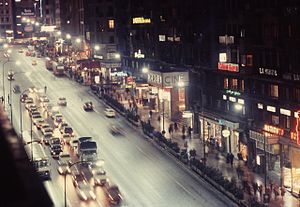Movida madrileña
The Movida Madrileña [ moˈβiða maðɾiˈleɲa ] (Spanish for Madrid movement ) was a cultural movement of urban youth, which emerged in the first years after Franquism and lasted until the 1980s .
history
After the death of Franco in 1975 and the associated transition to democracy in Spain , many Spaniards suddenly enjoyed freedoms that had previously been denied them. This led to a movement in the capital, Madrid , which wanted to experience everything shrill and exalted and which took on very hedonistic traits. The commemorative concert for Canito , drummer of the band Tos (shortly afterwards re-established as Los Secretos ), who was killed in a traffic accident in January 1980 at the College of Civil Engineering, is considered the prelude or first publicly perceptible appearance of the movement the Universidad Politécnica de Madrid took place with performances by Nacha Pop and Alaska y los Pegamoides , among others .
people
The best-known representative of the Movida Madrileña in Germany today is the film director and screenwriter Pedro Almodóvar . Whose first films such. B. "Pepi, Luci, Bom and other girls from the gang" ( Pepi, Luci, Bom y otras chicas del montón ) reflected the time of the Movida . Other important artists were the musicians Aviador Dro and Alaska, the pop groups Mecano , Los Nikis and Radio Futura , the graffiti artist Muelle (Spanish for pen ) and the fashion designer Ágatha Ruiz de la Prada .
Spread in Spain
Movida also found many followers and imitators outside of Madrid , so that it quickly spread to other major Spanish cities such as Vigo . This was pushed by primarily socialist politicians like the then mayor of Madrid Enrique Tierno Galván . They supported this cultural movement in order to provoke a clear break between the society of the post-Franco era and that of democracy. This had the advantage that the formerly anachronistic and fascist country could be presented abroad as modern and open-minded, although in many areas it was still stuck in the Francoist rut.
The legacy of the Movida
Today there are only a few bars in Madrid such as El Penta or La vía láctea in the Malasaña district , which have survived from the Movida era to today (as of 2009).
literature
- Julia Nolte: Madrid moves. The Movida revolution 1977–1985. Vervuert, Frankfurt am Main 2009, ISBN 978-3-86527-408-3 .
Web links
- Trailer of the documentation Rockola: Templo de la Movida (Youtube.com, in Spanish )
- Bar El Penta website (in Spanish )
- La vía láctea bar website (in Spanish )
